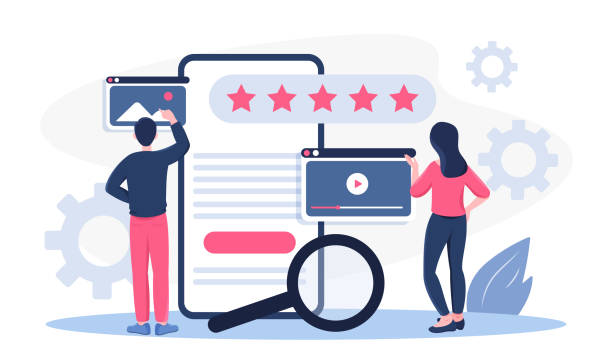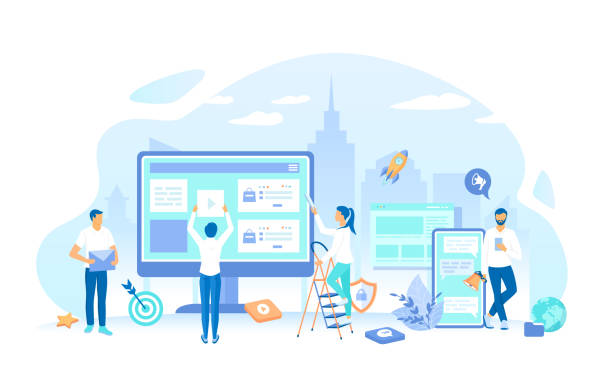The Importance of User-Friendly Website Design in Today’s Digital World

In the age of digital information and communication, an online presence is vital for every business.
But merely having a website is not enough; what truly makes a difference is the quality of the user experience provided.
#Educational User-friendly website design is an approach that focuses on users’ needs and expectations to provide them with a seamless and pleasant online experience.
This approach is not limited to visual aesthetics; it also includes ease of use, quick access to information, and effortless navigation across different pages of the site.
A user-friendly website encourages users to stay and interact more, which in turn leads to increased conversion rates, improved SEO, and customer loyalty.
Today’s audiences have high expectations from websites, and the slightest flaw in the user experience can lead to them abandoning the site and going to competitors.
Therefore, the importance of user-friendly website design goes beyond a mere aesthetic option; it is a strategic investment for long-term success in the online space.
In fact, a website that can correctly identify and respond to users’ needs not only provides information in an #explanatory manner but also builds a strong bridge between the business and its potential customers.
Hence, every web design project should start with a user-centric approach from the outset to yield the best results.
Do you dream of a thriving online store but don’t know where to start?
RasaWeb is your comprehensive e-commerce website design solution.
✅ Attractive and user-friendly design
✅ Increased sales and revenue⚡ Get free consultation
Understanding the Audience and Their Needs: The Foundation of User-Friendly Design

Before starting any design, a deep understanding of the target audience is of paramount importance.
Without correctly knowing who your users are, what their needs are, and how they interact with the internet, user-friendly website design will be practically impossible.
The process of audience understanding involves collecting data through various methods such as surveys, interviews, website analytics, and observing user behavior.
Tools like Google Analytics can provide valuable information about user demographics, interests, and how they interact with your website.
Creating user personas, which are hypothetical representations of your different audience groups, helps designers put themselves in the users’ shoes and shape designs based on their real-life scenarios.
This #analytical approach ensures that every design element, from navigation to content, is tailored to the audience’s expectations and needs.
#Guidance for web designers is to rely on data and research instead of guesswork to ensure that the final website is not only beautiful but truly useful and efficient for its users.
This fundamental step is the cornerstone of success in achieving the main goal of ergonomic website design.
User Interface (UI) and User Experience (UX): Differences and Synergy

The concepts of User Interface (UI) and User Experience (UX) are often used interchangeably, but in reality, they are two distinct yet complementary aspects of website design.
UI, or User Interface, refers to the visual look and feel of a website; elements such as colors, fonts, buttons, images, and overall layout.
This field is primarily concerned with aesthetics and how the user visually interacts with the digital product.
On the other hand, UX, or User Experience, deals with the user’s overall feeling when using a product or website.
This includes deeper aspects such as ease of use, efficiency, accessibility, and the pleasure of interaction.
A strong user experience requires a good UI and vice versa; a beautiful but unusable user interface results in a frustrating experience.
The most #specialized aspect here is understanding how these two work together to deliver a website with an excellent user experience.
In fact, UI is only part of the larger UX puzzle.
For a user-friendly website design, both must be carefully planned and executed.
For example, a beautiful button (UI) must be placed where the user can easily find it and understand its function (UX).
It is this synergy between UI and UX that leads to complete user satisfaction.
This #explanatory perspective helps designers focus not just on aesthetics but also on usability and effectiveness.
UI vs. UX Comparison
| Feature | User Interface (UI) | User Experience (UX) |
|---|---|---|
| Primary Goal | Aesthetics and visual interaction | User satisfaction and ease of use |
| Focus on | Appearance, feel, and arrangement of elements | Functionality, accessibility, and effectiveness |
| Examples | Button design, color schemes, fonts | Ease of navigation, loading speed, workflow logic |
Easy Navigation and Organized Information Architecture

One of the most important pillars of user-friendly website design is an easy Navigation system and a logical Information Architecture.
Users should be able to access the information they need without confusion and with the fewest clicks.
Complex and disorganized navigation can quickly frustrate users and cause them to leave the site.
Designing clear and understandable menus, using breadcrumbs to show the user’s position on the site, and organizing content into logical categories all contribute to improving the navigation experience.
Information architecture means organizing and labeling content in a way that is understandable and searchable.
This includes planning for page layout, information hierarchy, and the relationships between them.
For example, an e-commerce website should categorize its products in such a way that users can easily search for what they want, even if they don’t know the exact product name.
This #guiding approach significantly helps users find content.
Conducting usability tests with real users can reveal weaknesses in the navigation system and provide opportunities for improvement.
In fact, strong navigation is the backbone of an effective website and ensures that users can easily utilize the site’s full potential.
This #educational aspect of web design is crucial for online success.
Does your company website create a professional and lasting first impression in the minds of potential customers? RasaWeb, with its professional corporate website design, not only reflects your brand’s credibility but also opens a path for your business growth.
✅ Create a powerful and reliable brand image
✅ Attract target customers and increase sales
⚡ Get free consultation
Website Loading Speed and Performance Optimization

Website loading speed is one of the critical factors in user-friendly website design, often overlooked but directly impacting user experience and search engine rankings.
Today’s users have little patience, and every second of loading delay can mean losing a visitor.
Studies have shown that even small delays of a few hundred milliseconds can lead to an increase in bounce rate.
To achieve website performance optimization, several #specialized solutions exist.
These include image optimization (compression without quality loss), utilizing browser caching, reducing HTTP requests, compressing codes (CSS, JavaScript, HTML), and using Content Delivery Networks (CDNs).
Furthermore, choosing a reputable and fast hosting provider plays a significant role.
Tools like Google PageSpeed Insights can help you identify speed bottlenecks.
Continuous monitoring of performance and implementing necessary improvements is an essential part of website maintenance.
This #analytical aspect ensures that your site is always accessible and fast for its users.
A user-centric website design not only focuses on visual aesthetics but also places great importance on technical aspects that affect user experience.
Responsive Design for All Devices

In today’s world, where the use of mobile phones and tablets for internet access has become extremely common, Responsive Design is no longer considered an advantage but a necessity for any user-friendly website design.
Responsive design means that your website can automatically adjust its layout and content to the screen size of the user’s device, whether it’s a large desktop computer, a medium tablet, or a small smartphone.
This ensures a seamless and optimized user experience across all platforms and eliminates the need to create separate mobile versions or specific applications.
The importance of this issue is high not only from a user’s perspective but also from an SEO standpoint, as search engines like Google prioritize mobile-friendly websites in their search results.
To implement this #explanatory approach, CSS techniques such as Flexbox and Grid, as well as relative measurement units (like percentages or em), are used.
It is #educational that web designers start their design with a ‘mobile-first’ approach, meaning they first optimize the design for the smallest screen and then gradually expand it for larger screens.
This approach is especially crucial for ensuring the accessibility and functionality of the site across all devices.
Engaging, Useful, and Accessible Content

Content is king, and this principle applies even more so in user-friendly website design.
Even the best UI design and the fastest site cannot attract and retain users without engaging, useful, and relevant content.
Content should not only be #thought-provoking and captivating but also easy to read, understand, and search.
This includes using simple and fluent language, short paragraphs, clear headings and subheadings, and bulleted lists to improve readability.
Additionally, using visual elements such as high-quality images, videos, and infographics can enhance content appeal and present information in a more #entertaining and digestible way.
#Guidance for content creators is to always keep their target audience in mind and produce content that answers their questions, solves their problems, or provides them with new and interesting information.
Optimizing content for search engines (SEO) is also of high importance, to ensure that your valuable content is found by potential users.
Adhering to accessibility principles in content, such as using alternative text (alt text) for images and captions for videos, also ensures that your content is accessible to all users, including those with disabilities.
This set of tips elevates UI and UX optimization to a higher level.
User-Friendly Content Checklist
| Feature | Description |
|---|---|
| High Readability | Use of appropriate font, sufficient size, short paragraphs, and ample white space. |
| Useful and Relevant | Providing real value to the user, answering questions, and addressing needs. |
| Appropriate Formatting | Use of headings, bullets, and numbering for easy scanning. |
| SEO Optimization | Use of relevant keywords, meta descriptions, and internal/external linking. |
| Visual Appeal | Use of relevant and high-quality images, videos, and graphics. |
Accessibility: Designing for All Users

Accessibility in website design means ensuring that your website is usable by all individuals, regardless of their physical or mental abilities.
This includes people with visual, hearing, motor, or cognitive impairments.
A truly user-friendly website design must include accessibility principles so that no user is deprived of the experience of using the site.
Adhering to global standards like WCAG (Web Content Accessibility Guidelines) can help designers create inclusive websites.
These principles include using alternative text for images (alt text) so that visually impaired individuals can understand image content, providing captions for videos for the deaf, enabling keyboard navigation for those who cannot use a mouse, and ensuring appropriate color contrast for people with color blindness.
This #specialized approach is not only ethically correct but can also significantly expand your target market.
#Guidance for developers is to integrate accessibility testing tools into their design process and benefit from feedback from users with disabilities.
By adhering to these principles, a UI optimized website will literally be accessible to all users and create a positive experience for them.
Did you know that customers’ first impression of your company is your website? Multiply your business’s credibility with a powerful corporate site from RasaWeb!
✅ Custom and eye-catching design tailored to your brand
✅ Improve user experience and increase customer attraction
⚡ Get free consultation!
Usability Testing and Feedback Collection

After designing and implementing a website, the work is not over.
To ensure that user-friendly website design has truly achieved its goal, conducting usability tests and collecting user feedback is essential.
Usability testing involves observing real users as they interact with the site and identifying weaknesses or problems they may encounter.
This #analytical method helps you uncover navigation issues, content ambiguities, or any obstacles that affect the user experience.
There are various methods for usability testing, including A/B testing, five-second tests, card sorting, and field studies.
Feedback collection can be done through online forms, surveys, email, or social media.
Also, analyzing website data (such as bounce rate, time on page, and navigation paths) can provide valuable insights.
This #informative and iterative process means that after collecting feedback and implementing changes, testing should be conducted again to ensure the effectiveness of the improvements.
This continuous approach to optimization ensures that your website always aligns with users’ needs and expectations and provides a flawless experience.
Future Trends in User-Friendly Website Design and Innovations

The world of web design is rapidly evolving, with new trends constantly emerging to enhance user experience.
To maintain a user-friendly and competitive website design, awareness of these trends and readiness to adopt them are crucial.
One of the most important future trends is the broader use of Artificial Intelligence (AI) and Machine Learning for personalizing the user experience.
These technologies can tailor content, products, and even website layout based on user preferences and past behavior.
Voice User Interfaces (Voice UI) are also growing, especially with the increasing popularity of voice assistants.
This means that websites need to be optimized for voice interactions as well.
Microinteractions – small visual details or auditory feedbacks that occur in response to user actions – have also become important for adding an #entertaining feel and improving instant feedback to users.
Virtual Reality (VR) and Augmented Reality (AR) also hold great potential for providing more interactive and immersive experiences.
These trends indicate that the future of website design goes beyond merely static and textual pages, moving towards richer, more personalized, and smarter experiences.
Staying at the forefront of #new knowledge and the latest techniques is a necessity for every web designer to provide the best website with an excellent user experience.
Frequently Asked Questions
And other advertising agency services by RasaWeb in the field of advertising
- Smart Data Analysis: Transform customer acquisition with custom programming.
- Smart Google Ads: Professional optimization to increase sales using smart data analysis.
- Smart Data Analysis: A creative platform to improve SEO ranking through Google Ads management.
- Smart Sales Automation: A creative platform to improve customer acquisition with custom programming.
- Smart Customer Journey Map: A combination of creativity and technology for campaign management through custom programming.
And over hundreds of other services in the field of internet advertising, advertising consulting, and organizational solutions
Internet Advertising | Advertising Strategy | Advertorials
Resources
Website Design Principles
UI and UX Design Principles
What is User Experience (UX)?
Website UI and UX Design Principles
? RasaWeb Afarin, by offering comprehensive digital marketing services, from multilingual website design and SEO to content marketing and social media, guides your business to new horizons of success. Contact us for consultation and to enhance your online presence.
📍 Tehran, Mirdamad Street, next to Bank Markazi, Kazeroon Janoubi Alley, Ramin Alley, No. 6



